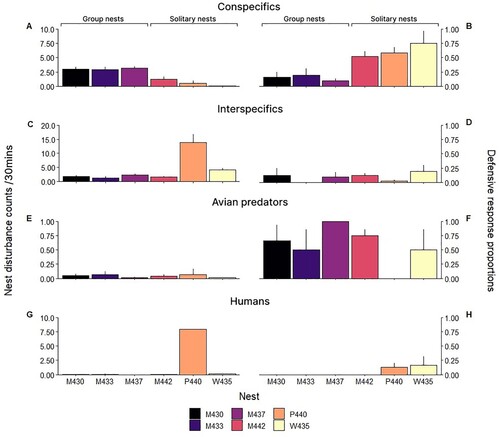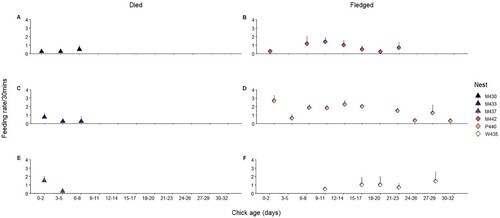Figures & data
Figure 1. Left column: Average (+SE) nest disturbance count of A, conspecifics, C, interspecifics, E, avian predators and G, humans recorded within 30 m of each nest. Right column: Proportion (+SE) of defensive response by NZFT from each nest towards disturbance type, B, conspecifics, D, interspecifics, F, avian predators and H, humans over a 30 min period. Nests have been indicated by colour.

Figure 2. Left column: Nests which had chick(s) that died and did not fledge A, M430, C, M433 and E, M437. Right column: Nests which had chicks that did fledge (chicks surviving >32 days) B, M442, D, P440, F, W435. Y axis: average number of fish brought back to the nest and consumed by the chick (+SE). X axis: age (in days) of the chick, grouped into three-day periods (0–2, 3–5, 6–8, etc.), using the older age of the two chicks if more than one is present in the nest. Feeding rates per chick in the nest are reported to enable comparison of single and two chick nests. Counts were made in continuous observations over a 30 min period. All chicks that shared a nest hatched a day apart. Semi-successful and successful nests (where chick(s) fledged) are represented with a circle. Chicks that died before reaching 10 days old are represented with a triangle. Nest P440 became a solo parent nest when the chick was five days old. Nest W435 had two chicks. Nest M442 had two chicks until the younger of the two died at 17 days old. Nest M433 had two chicks that both died at 7/6 days old. Observations for nest W435 began when the chicks were 12/11 days old until the chicks fledged. Observations for nest M442 ended when the chick was 24 days old, prior to the chick's fledging. Observations for nest P440 were made until fledging. The nests are identified by colour, consistent with .

Table 1. The number of 30-minute observation periods (obs.) for six nesting attempts by breeding NZFT pairs in relation to chick age (in three-day periods).
